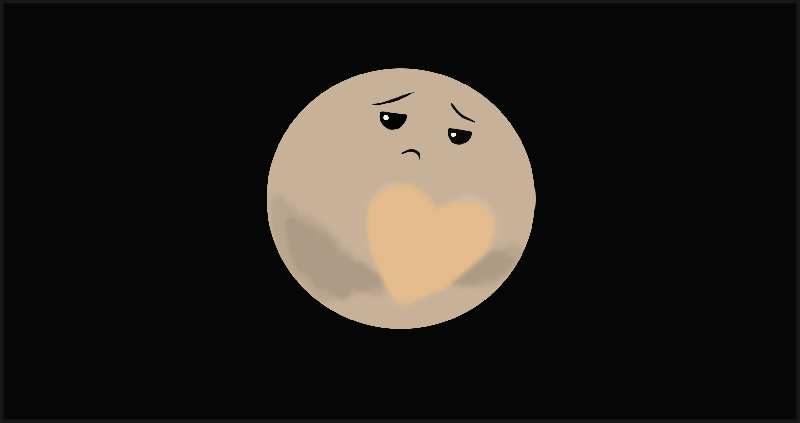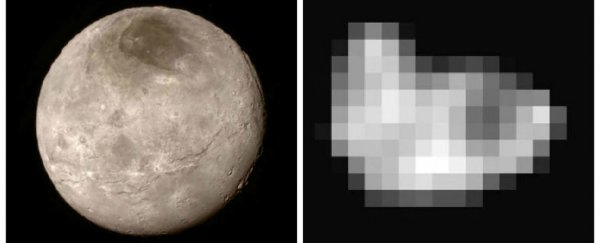First off, let's just take a moment to appreciate that 14 July 2015 was when humankind discovered that that pluckiest non-planet of them all carries a heart on its belly like some kind of inanimate Care Bear Cousin.
And now we get our first ever look at two of its moons, Charon and Hydra. While one looks a hell of a lot better than the other, it's incredible the kind of information we can glean, both from a beautifully detailed image taken from 466,000 kilometres (289,000 miles) away, and a bunch of blurry pixels that accumulate to make the vague shape of something lurking 645,000 km (400,784 miles) away.
Firstly Charon, the largest of Pluto's five moons. The image was taken on 14 July, just nine hours before NASA's New Horizons spacecraft made its historic flyby of Pluto. Taken by its high-resolution, monochromatic LORRI camera, the image has a resolution of 2.3 km per pixel, which is the best we've ever been able to achieve. Here's what you're looking at, according to a NASA press release:
"The image has been compressed to reduce its file size for transmission to Earth. In high-contrast areas of the image, features as small as 3 miles (5 km) across can be seen. Some lower-contrast detail is obscured by the compression of the image, which may make some areas appear smoother than they really are. The uncompressed version still resides in New Horizons' computer memory and is scheduled to be transmitted at a later date."
With a diameter of 1,200 km and a surface area of 4.6 million square km, Charon has half the diameter of Pluto and half the surface area of Australia, according to Mika McKinnon and Maddie Stone at io9. We can see in the new image that its surface is relatively smooth, with far few craters than would be expected for something that's been jostled about in the Kaiper belt as much as it has.
And what can this tell us about the little moon? "This raises the fascinating possibility that the moon is geologically active!" say McKinnon and Stone. "But, to be fair, we don't know exactly how many craters are on this image, and we'll get additional data tomorrow. The fascinating gash across Charon's surface is also revealed in the highest resolution to date - this feature is way, way bigger than the Grand Canyon, with a band of cliffs and troughs stretching over 1,000 km (600 miles)."
Another awesome feature is darkish region of Charon's north pole, which the New Horizons team has nicknamed Mordor.
"Charon blew our socks off," one of the team, Cathy Olkin from the Southwest Research Institute in the US, told Nicky Phillips at The Sydney Morning Herald.
And then we have Hydra, which isn't much to look at right now, but it's got a hell of a lot of mysteriousness going for it. The image was taken hours before the Pluto flyby, and the LORRI camera managed to capture an image with a resolution of 3.2 km per pixel. What we can already tell from this cluster of pixels is that it's about 48 km by 33 km (27 miles by 20 miles), and it's certainly not the nice, round shape of its sister moon, Charon.
According to one of the New Horizons team, Hal Weaver, the variation in brightness seen on the surface suggests that Hydra's outer layer is made up of mostly water ice. "Its surface is primarily water ice. That's cool," he said.
Tomorrow we should get our first glance at another of Pluto's moons, Nyx. And we can't wait. With 16 more months of new information coming in about Pluto and its family, we're about to have a hell of a time learning about the newly crowned 'King of the Kuiper Belt'. As New Horizons mission scientist Andy Cheng said, "If you can imagine … Christmas, but you don't get all your presents at once, you get them in installments, spread out. That's what's going on. Every day you get a little more of your Christmas present."
We'll leave you with the most heart-breakingly adorable gif we've seen in a very long time, courtesy of BennuBird on Imgur:

